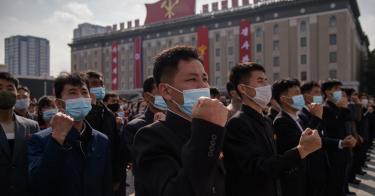As cases of COVID-19 continue to spike across the globe, so too does the demand for Personal Protective Equipment (PPE). An investigation conducted by The Guardian found that some factories producing PPE in Dandong, China, are now using forced labor to meet increased demand.
The Guardian’s investigation found that predominately North Korean women are being forced to work 18 or more hours per day in factories producing primarily protective coveralls. The alleged North Korean-produced PPE is believed to have made its way into U.S., UK, and several other markets in Asia and Europe.
In 2018, diplomatic negotiations between the U.S. and North Korea cast a spotlight on the regime’s export of forced labor. At that time, U.S. diplomats visited several capitols around the globe to persuade them to banish North Korean laborers and abide by United Nations Security Council Resolution 2397 that stipulated that all North Korean forced laborers return home prior to December 31, 2019. While many countries complied, others—including the primary culprits, Russia and China—did not.
In addition to the significant human rights concerns attending the use of North Korean forced labor, there are also security implications. The Guardian report, for example, estimates that the Kim regime garnishes at least 70 percent of the North Korean women’s wages. There can be no question that the North Korean regime has mastered the art of exploitation. It is, after all, profiting from forced labor in the midst of a pandemic.
While the exact figure is disputed, one report estimated that the Kim regime may generate profits of $1.2 to $2.2 billion annually from forced labor. Other reports suggest profits are between $500 million and $975 million. If the first estimates are correct, revenue from forced labor may have constituted as much as “93 percent of North Korea’s total exports in 2016.” These profits may even be used to prop up Pyongyang’s illegal nuclear and missile weapons programs.
The U.S. response to North Korean forced labor increased dramatically in recent years. This year, for the first time ever, the U.S. released a list of state sponsors of forced labor; North Korea was one of the 10 countries listed. All countries so designated are automatically placed on Tier 3—the worst designation a country can receive in State Department’s annually released Trafficking in Persons (TIP) report. North Korea has been on Tier 3 for the last 20 years since the first TIP report was issued in 2000.
In addition, the Department of Homeland Security (DHS) and the U.S. Customs and Border Protection (CBP) have ramped up efforts to stop goods produced with forced labor from entering the U.S. market under the 2017 Countering America’s Adversaries Through Sanctions Act (CAATSA) and the Tariff Act of 1930. CAATSA created a rebuttable presumption that all good produced by North Koreans were made with forced labor. It also grants CBP authority to stop North Korean goods from entering the country, which makes it all the more troubling that PPE produced by North Korean forced laborers may have made their way into U.S. markets in 2020. Given the evidence presented by The Guardian, it seems that, at a minimum, the claims merit an investigation by DHS to determine their veracity.
Nearly two years ago I argued that the U.S. government should make greater use of policies that sit at the intersection of human rights and national security concerns, as policies to mitigate forced labor do. That argument still stands.
The next administration will face a formidable threat from North Korea, one that is, in no small way, funded off the backs of ordinary North Korean people. The U.S. would do well to continue crafting and enforcing policies that seek to mitigate the regime’s human rights violations alongside and in concert with efforts to address security threats.
This piece originally appeared in Forbes https://www.forbes.com/sites/oliviaenos/2020/12/02/responding-to-reports-of-north-korean-produced-ppe-making-their-way-into-the-us-during-the-covid-19-pandemic/?sh=40b507891d65



